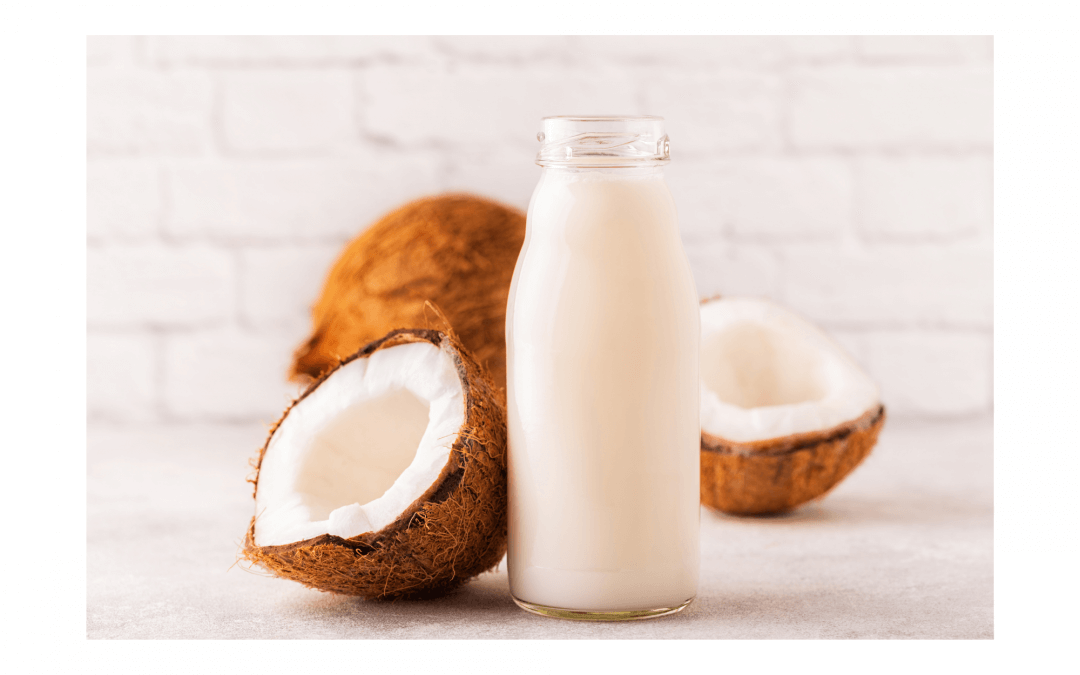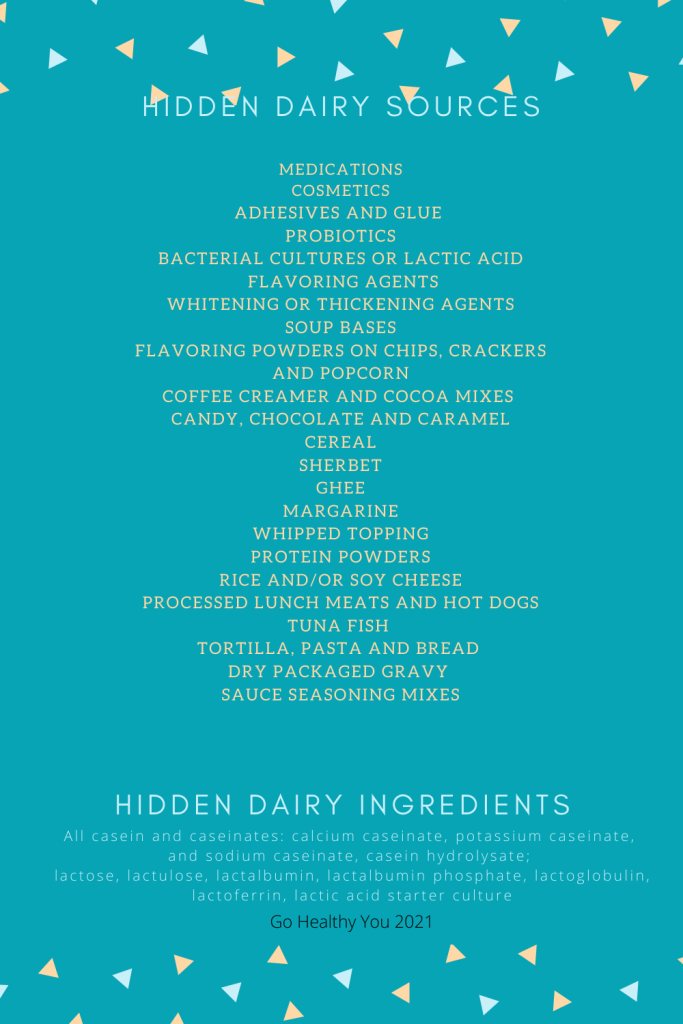Take a quick trip down the grocery aisle and you’ll likely see a lot of plant-based “milk” alternatives. Great news if you are moo-ving away from dairy to taste new products made with cashew, oat, coconut, soy, hemp or even macadamia. The not-so-great news is how confusing it is to navigate the plant-based world of “milk-alternatives”, especially when it comes to the labels ‘non-dairy and dairy free’.
Non-dairy and dairy free…these are not the same!
Do a quick google search of the word “dairy”.
The simpliest and most straightforward from Merriam-Webster.com dictionary defines dairy as ‘milk from a cow or other domestic animal (such as a goat); food (such as ice cream, cheese, or yogurt) made primarily of, or from, milk’. This dairy industry standard states that dairy is ‘derived or made from milk; from cows or other mammals like sheep and goats’. The USdairy association defines milk as ‘basically any dairy variety (skim, 1%, etc…) that comes from a cow’. Lastly, as of April 2020, under the code of federal relations, the FDA chimes in to say this about milk ‘…lacteal secretion…obtained by complete milking of healthy cows’.
Pretty clear, right? No, it’s not!
If dairy is derived from milk, then we should conclude that non-dairy AND dairy free are NOT derived from, nor contain, any ingredient from milk (either cow, sheep, goat or other mammal).
But watch this, according to our diary-free resources, the FDA states that these terms, non-dairy and diary free, are NOT equivalent, and further states: “We have interpreted the term “dairy free” as meaning the complete absence of all dairy ingredients including lactose, etc. The term “nondairy” refers to products, such as nondairy whipped topping and nondairy creamers, that may contain a caseinate milk”.
It’s JUST not that simple. And here’s why!
Dairy milk contains the proteins casein (82%) and whey (18%).
Try to recall the 1800’s nursery rhyme, Little Miss Muffet. Well, she sat down on a tuffet eating her curds and whey; yep she was eating (or drinking) a milk product that naturally contained casein and whey. A quick label check will show you that whey (the liquid part of milk which is strained from the curd) is clearly identified as none other than—WHEY.
But the CURDS, on the other hand, is not clearly labeled as “curds”. And unless you remember our Muffet rhyme, chances are you have just had a non-dairy product containing casein (aka curds, aka dairy). Most notable non-dairy foods containing casein are non-dairy coffee creamers, sherbet, whipped topping, and even non-dairy cheese. Food companies will state a product is non-dairy, even if it contains a fraction of casein.
Recently the FDA revised the food labeling law (reference: 21 CFR 101.4(d)) to say this: “In addition, milk and ingredients derived from milk such as casein (a milk protein) are major food allergens. Federal law requires the source of sodium caseinate to be indicated in the ingredient statement of a label, e.g., “sodium caseinate (milk).” Alternatively, the source of this ingredient may be indicated in a contains statement immediately after or adjacent to the ingredient statement, e.g., “Contains: milk.”
This is serious stuff!
Cow’s milk allergy is the most common food allergy across the age spectrum from infants and children, to adults. Milk is now listed as one of the nine major allergens, and must be listed as such on the food label.
Few cases of whey sensitivity exist, but most often the slowly digested casein protein is the serious food allergy culprit, wreaking gut havoc in the digestion process. In a good way, slow digesting casein protein helps to build and maintain muscle mass. In a not so good way, (for those with allergies and sensitivities), this slow digesting protein can aggravate digestion. Symptoms of a gut leaking large, undigested casein protein molecules will appear as stomach pain, bloating, diarrhea, skin issues, and more. If you experience any of these symptoms, it is likely you have a food sensitivity issue and need nutrition solutions.
We’re in the home stretch!
It’s not just grocery aisle ingredients that we need to investigate. Thankfully, great online resources are available to help us locate those less-than-obvious products that hide dairy. Food Allergy Research and Education and Kids with Food Allergies provide up-to-date food recalls, and downloads with foods and ingredients that may contain hidden dairy. Some ingredient names will appear as: all casein, caseinates: calcium caseinate, potassium caseinate, and sodium caseinate, casein hydrolysate; lactose, lactulose, lactalbumin, lactalbumin phosphate, lactoglobulin, lactoferrin, lactic acid starter culture.
Keep scrolling for the bottom line!
For the dairy free shopper!
Every day, more dairy free products appear on the shelves, and that makes my shopping easier.
I thought I’d share a few of my personal dairy free favorites, but by no means is this an exhaustive list. I like this dried coconut milk creamer for my cup of Joe, but mostly appreciate their single serve packets to take on the road. For fiber and protein snack bars, these are some of the tastiest varieties: chewy coconut cashew, crunchy granola fruit and seed, double chocolate brownie fig. When I’m blending up a nutritious smoothie, I’ll add this clean, plant based protein powder. But for a quick grab and go, super creamy protein drink, this 100% plant based drink is a winner because it comes from a dedicated allergen-free company.
Now for the bottom dairy free line…
- Read the packaging label and/or menu. Just because the front packaging or menu item says non-dairy doesn’t mean the product is truly free of any milk derivative.
- Non-dairy foods will sometimes contain milk products, like casein, lactose or milk fat.
- When in doubt, purchase Vegan items. These are truly dairy free and will not contain any animal (milk) ingredients.
- Vegan is a safe dairy free option.
- Products packaged with teal awareness ribbons will usually verify that the product is free from the top common allergens, but again—read the ingredients.
- Support companies making products from dedicated allergen free facilities
- When in doubt, contact the company. Most food companies offer customer service help, and if the allergens are not clearly labeled on their website, they are usually able to provide you with an answer in short time.
- Look for foods labeled free from the top 9 common allergens
- Check out the ingredients list. Manufacturers hide milk under different names. Become a food detective and investigate an ingredient that doesn’t sound familiar.
- Dairy free foods will NOT contain any source of milk, casein, lactose or milk fat.
Disclaimer: This post contains a few affiliate links to companies offering truly dairy free foods


